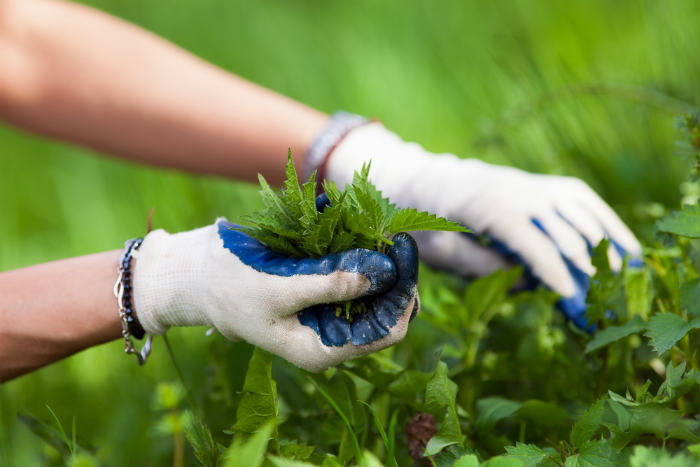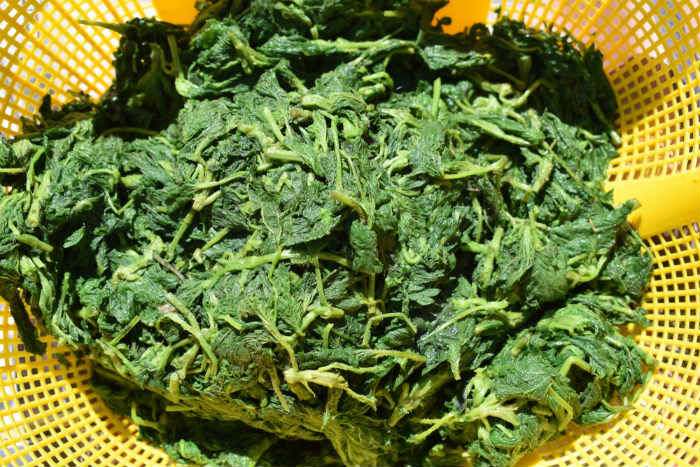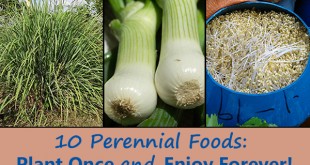Stinging Nettle Tea: How to Make It and The Benefits

It’s hard to imagine a plant named stinging nettle could be a good thing. Anyone who has grabbed these plants with their bare hands understands that it’s not comfortable. The sting from stinging nettle can last hours. Who would think about making stinging nettle tea?
Stinging nettle is a wild herb that can be used in soups, cheeses, ingested as a tea, or made into an infused oil. Nettle tea is a springtime favorite because it is one of the earliest green plants that sprout up as the temperatures warm.
As you might have guessed, this plant needs to be handled with care. Be sure to use gloves when you harvest the plant, and keep it away from small children. Luckily, once cooked or brew, this herb loses its stinging power.
That being said, stinging nettle has long been known for its different health benefits. It’s a cure for many common ailments we face on a regular basis.
The Benefits of Stinging Nettle
Stinging nettle has many known benefits. Drinking nettle tea treats a range of issues. For example, we know that it can be used to improve your heart function, get rid of headaches, dissolve kidney stones, and purify your blood. These benefits help to drive out toxins and wastes, causing the kidneys to excrete more water.
-
Natural Detox
If you want to naturally detox your body, drinking stinging nettle can be helpful because it’s a natural diuretic. It flushes toxins out of your system. Taking stinging nettle can also help to boost your lymphatic system to get rid of toxins throughout your body.
-
Helps with a Painful Labor
If you’re facing childbirth soon, stinging nettle can be part of your birth plan. This herb is said to ease childbirth pain, and it’s a natural coagulant, so it can help with excessive bleeding during childbirth as well.
-
Increases Milk Production
Do you have issues with milk production? Many women face troubles with producing breast milk, and drinking stinging nettle teas can give you the boost that’s necessary to make nursing easier.
-
Reduces Menstrual Cycle Severity
Some women have very heavy menstrual cycles, and it can be debilitating in some cases. If you want a natural option to help reduce your menstrual cycle severity. Remember that stinging nettle is a natural coagulant, so it can help reduce your flow and minimize blood loss.

-
Boosts Red Cell Production
Stinging nettle is high in iron and vitamin C, and that helps to boost your red blood cell production. If you have low red blood cells, you’ll struggle with fatigue and anemia. With higher red blood cells, you’ll notice that your wound recovery time increases.
-
Anti-Inflammatory Properties
Inflammation is caused by trauma, and it’s a natural response, which is okay in standard, small amounts. For example, if you hurt your knee and it swells up for the day, that is a normal reaction. The inflammation goes away quickly, but chronic inflammation is an issue.
Stinging nettle has natural anti-inflammation properties, so it can help heal chronic inflammation caused by gout, arthritis, and muscle pain.
-
Treatment for Allergies
Stinging nettle is a natural treatment for allergies and asthma. You will need to continue taking stinging nettle tea regularly to help you breathe better, but it’s worth it!
-
Reduces Nausea and Diarrhea
No one likes dealing with tummy issues. Stinging nettle can help you by reducing nausea and diarrhea. It also reduces ulcers and hemorrhoids.
How to Make Stinging Nettle Tea
To reap the benefits of stinging nettles, making a tea out of the plant is the easiest thing to do. It’s simple to make.

Protect Yourself While Harvesting
As mentioned before, you need to be careful when you harvest stinging nettle. It has points on the leaves that will catch your skin and cause stinging for hours. You need to cover your hands and arms. Try wearing gloves and long sleeves, depending on how tall the plants are.
If you decide to take children along with you when you harvest nettles, make sure your child wears gloves and long sleeve shirts as well.
Steps to Make Stinging Nettle Tea
- Remove the leaves from the stems with gloved hands. Use scissors or garden clippers to cut the top two bracts of leaves, leaving the rest of the plant to regrow.
- After harvesting, rinse the leaves under cold water and place them in a pot full of water. In general, you need two cups of water per one cup of leaves.
- Bring the pot to a low boil, then turn it to simmer. Simmer the leaves for at least two minutes. If you like a stronger tea, then steep the leaves in the water for a longer time. If you prefer a mild flavor, add more water.
- After the leaves are done steeping, strain the leaves out of the pot. Pour the tea into a cup and sweeten as you like.
You can make stinging nettle tea with dried leaves as well. Drying the leaves in the spring and summertime means you can drink this tea throughout the fall and winter. All you need is one teaspoon of dried leaves per one cup of water.

You Can Eat the Leaves
You also can eat nettle leaves. Nettle leaves can be eaten with some melted butter over the top. You can add them to soups or stews. There are recipes for nettle bread, mead, and cookies – seriously. People have developed exciting recipes using stinging nettle.
Is Nettle Tea Safe?
You might be wondering if it’s safe for children and adults to drink stinging nettle tea. Yes, nettle tea is relatively safe for kids and adults, but you can always discuss with a medical doctor before taking any new herb.
Like anything new, you should gradually introduce nettle tea to your body. A cup or two per day is sufficient to reap the benefits of the herb. If you’ve never drunk nettle tea before, start with one cup a day until you know if your body tolerates it.
 Home and Gardening Ideas At home and Gardening ideas we believe inspiring readers about homesteading, self sufficiency
Home and Gardening Ideas At home and Gardening ideas we believe inspiring readers about homesteading, self sufficiency






One comment
Pingback: How To Make Stinging Nettle Tea